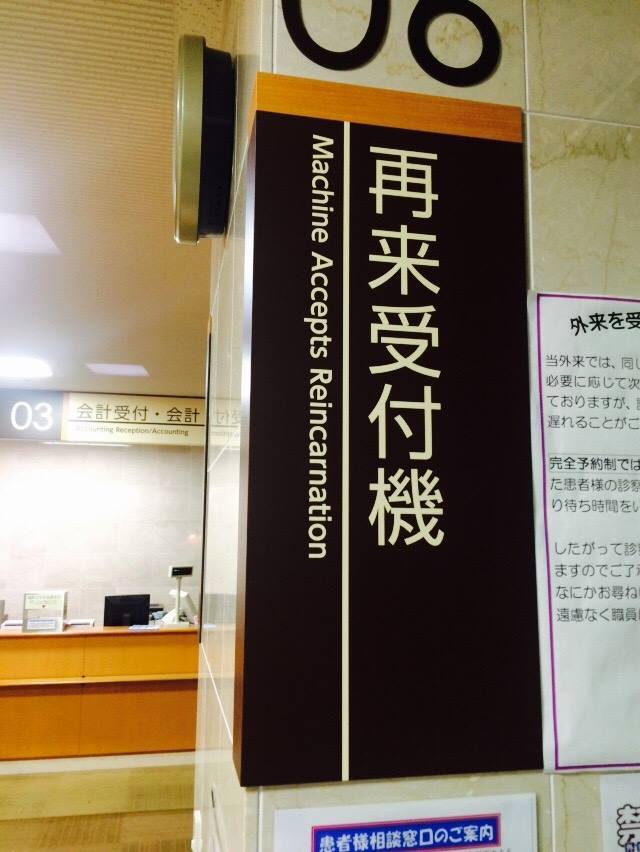Machine accepts reincarnation
« previous post | next post »
Posted on Facebook by Aaron Gerow (Yale):
The photograph was taken in a Japanese hospital, where this wondrous machine is for automatic reception of returning patients.
sairai uketsuke-ki 再来受付機 ("return reception machine")
The mistake is obviously with sairai 再来 ("return"), though why "reincarnation" was chosen as the English translation is as mysterious as transmigration.
Not surprisingly, Japanese generally uses the typical Buddhist lexicon for reincarnation (rin'netenshō 輪廻転生 ["metempsychosis"], etc). Sairai 再来 is occasionally used in the sense of "the reincarnation of [insert dead celebrity here]," so perhaps this accounts for the suggestion that this machine is totally cool with reincarnation.
Nathan Hopson, who called this gem to my attention, comments:
Part of the giggles for me was the polysemous possibilities of the mistranslated English: does the machine "accept" patients requiring reincarnation? requests for reincarnation? the idea of reincarnation?
Whatever the machine actually does, it must be miraculous.

Anschel Schaffer-Cohen said,
November 1, 2015 @ 3:26 pm
Have you ever considered posting kana along with kanji and romanization when you post Japanese text? I find it slightly disconcerting to read the romanization, and I'm not kanji-literate.
R. Sode said,
November 1, 2015 @ 3:51 pm
This one's easy. The person in charge of the English sign just used an on-line dictionary like Weblio. The Weblio Japanese-English dictionary's entry for 再来 [sairai] first notes that this is a 形式張った表現 [けいしきばったひょうげん] 'formal expression' and lists the English translations 'a second coming (advent)'. You see where this is going. The example sentence on that page is 彼はミルトンの再来だ [かれはミルトンのさいらいだ] 'He is a second Milton.' 'He is Milton reincarnate'. Since Japan still is not a country where a company or organization can easily find a bilingually literate person, and a professional translator is not consulted unless they have a major translation project, anyone with access to the internet with very poor sense of the foreign language is given the task and voila, pseudo-translations. Anyone who has studied a foreign language seriously would re-check the apparent translation in the other direction (in this case, check an English-Japanese dictionary for 'reincarnation') and find out that that's not what the original word meant.
RS
Victor Mair said,
November 2, 2015 @ 7:57 am
@Anschel Schaffer-Cohen
"Have you ever considered posting kana along with kanji and romanization when you post Japanese text?"
Yes, I once briefly thought about doing that, but rejected the idea for the following reasons:
1. having romanization, kana, kanji, and English translation for each Japanese word, phrase, or sentence that I cite would take up too much space and would potentially confuse whatever point I was trying to make about grammar, meaning, etc.
2. presenting the romanization of the kana and the kana simultaneously would be an unnecessary redundancy
3. everybody who reads Language Log can read Roman letters, but only the tiniest fraction can read kana
I'm relieved that you find it only "slightly disconcerting" not to have the kana alongside the romanization.
PeterL said,
November 2, 2015 @ 7:10 pm
I showed this to a native speaker who said that he'd never use the word "reincarnation" for 再来.
However:
https://kotobank.jp/word/%E5%86%8D%E6%9D%A5-508606
一度死んだ人がまた生まれてくること。
(大辞林 第三版)
Jim Breen said,
November 3, 2015 @ 5:57 am
It need not have been an online dictionary such as Weblio that led to that translation. The 5th edition of the big Kenkyusha (GG5) has it as the main translation, as do smaller Kenkyushas. GG5 relegates the more modern usage to a subsidiary example (再来患者 a follow-up patient; a repeat patient).
krogerfoot said,
November 3, 2015 @ 6:02 am
I disagree a bit with R Sode above. Japan is rather awash with English-language resources and services. This kind of error is a big pet peeve of mine. I don't get bent out of shape about mistakes in good-faith efforts to communicate in foreign languages, but this is so careless that it makes you wonder.
In a culture where attention to detail is taken so admirably seriously, I can't understand why someone would go to all the trouble and expense to create this obviously professionally-done signage and yet not allocate a few bucks to have the translation checked. (You can see the English in the background is perfect, so I wonder who let this one get by.)